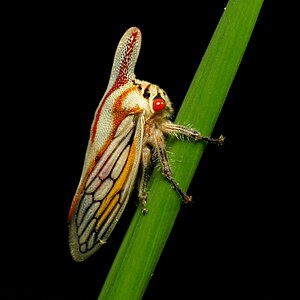Platycotis
| Platycotis | ||||||||||||
|---|---|---|---|---|---|---|---|---|---|---|---|---|

Platycotis vittata , in Virginia |
||||||||||||
| Systematics | ||||||||||||
|
||||||||||||
| Scientific name | ||||||||||||
| Platycotis | ||||||||||||
| Stål , 1869 |
Platycotis is a genus of humpback chirps from the subfamily Membracinae . Nine species of the genus are known, which are divided into two sub-genera. The chirps occur in northern South America as well as in Central and North America.
features
The platycotis chirps are relatively large, approx. 10 to 13 mm long, yellow, brown or brown-green in color, often with red lines on their pronotum. The head is broad, twice as wide as it is high. The forewings have two yellow or white elongated markings. The surface of the pronotum is clearly dotted, the individual points are each equipped with a small hair. The pronotum extends backwards approximately to the tip of the abdomen; a noticeable forward-facing process is often but not always formed. It can be developed in males and / or females and can vary greatly within a species. Without this extension, the length of the animals is approx. 8 to 9 mm. The middle leg has a triangular structure on the coxa. The tarsi of the hind legs are noticeably small.
Distribution and types
- Subgenus Lophopelta
Stål
- P. histrionica (Stål) , known from Guatemala and Mexico
- P. nigrorufa (Walker) , from Ecuador, Guatemala and Mexico
- P. tuberculata (Fairmaire) , from Guatemala, Mexico and USA
- Subgenus Platycotis Stål
- P. acutangula Stål , from Guatemala and Mexico
- P. cornuta Plummer , from Mexico
- P. fuscata (Fowler) , from Mexico
- P. minax Goding , from Mexico and USA
- P. salvini (Fowler) , from Mexico
- P. vittata (Fabricius) , from Mexico, USA and Canada (the species was also wrongly reported for Brazil).
The species P. vittata is best known, it is known in the USA as "oak treehopper" because it occurs mainly on oaks and causes damage in the process. Targeted control is not necessary, however.
Way of life
The females lay their eggs in woody tissue. Around the puncture site for the eggs, the females make further punctures in the tissue, which then make it easier for the larvae to suck up the plant sap ( phloem ). The females guard their eggs and nymphs; in P. vittata a female was observed to actively defend her young from a small wasp . The chirps (adults with larvae) are usually found in groups. Platycotis -Zirpen be of birds and grave wasps pursued.
P. vittata sucks mainly on oaks , other species have also been observed on birch , witch hazel , Myricaceae and plane trees .
Individual evidence
- ^ A b c S. H. McKamey: Taxonomic Catalog of the Membracoidea (exclusive of Leafhoppers). In: Memoirs of the American Entomological Institute . tape 60 , 1998, pp. 1-377 .
- ↑ a b c d e oak treehopper - Platycotis vittata (Fabricius). Retrieved February 3, 2018 .
- ^ A b c d C. Godoy, X. Miranda & K. Nishida: Treehoppers of tropical America . Instituto national de Biodiversidad, Santo Domingo de Heredia, Costa Rica 2006, ISBN 9968-927-10-4 , pp. 352 .
- ↑ a b c Funkhouser, WD: Homoptera. Fam. Membracidae . In: Genera Insectorum . tape 208 , 1950, pp. 1-383 .
- ↑ a b c S. H. McKamey & LL Deitz: Generic Revision of the New World tribe Hoplophorionini (Hemiptera: Membracidae: Membracinae) . In: Systematic Entomology . tape 21 , 1996, pp. 295-342 .
